The Quaker Tapestry consists of 77 panels illustrating the history of Quakerism from the 17th century to the present day. The idea of Quaker Anne Wynn-Wilson, the tapestry has a permanent home at the Friends Meeting House at Kendal, Cumbria, England.

Gracechurch Street is a main road in the City of London, the historic and financial centre of London, England, which is designated the A1213.

The Yearly Meeting of the Religious Society of Friends (Quakers) in Britain, also known as the Britain Yearly Meeting, is a Yearly Meeting of the Religious Society of Friends (Quakers) in England, Scotland, Wales, the Channel Islands and the Isle of Man. It is the national organisation of Quakers living in Britain. Britain Yearly Meeting refers to both the religious gathering and the organisation. "Yearly Meeting", or "Yearly Meeting Gathering" are usually the names given to the annual gathering of British Quakers. Quakers in Britain is the name the organisation is commonly known by.

East Barnet Valley was a local government district from 1863 to 1965 around the town of East Barnet. It was partly in the counties of Hertfordshire and Middlesex until 1889, when the Middlesex part was transferred to Hertfordshire. It was renamed East Barnet in 1935.

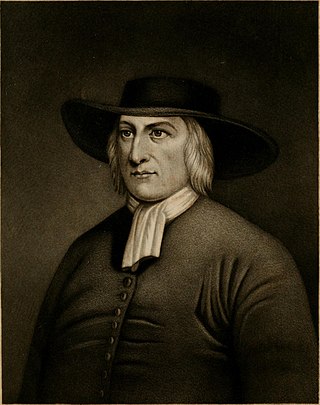
Quakers are people who belong to a historically Protestant Christian set of denominations known as the Religious Society of Friends. Members of these movements are generally united by a belief in each human's ability to experience the light within or "answering that of God in every one". Some profess a priesthood of all believers inspired by the First Epistle of Peter. They include those with evangelical, holiness, liberal, and traditional Quaker understandings of Christianity. There are also Nontheist Quakers, whose spiritual practice does not rely on the existence of God. To differing extents, the Friends avoid creeds and hierarchical structures. In 2017, there were an estimated 377,557 adult Quakers, 49% of them in Africa.
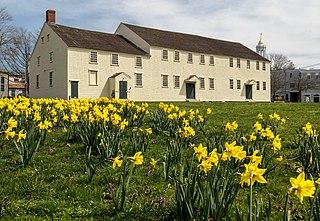
A Friends meeting house is a meeting house of the Religious Society of Friends (Quakers), where meeting for worship is usually held.
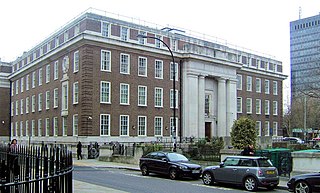
Friends House is a multi-use building at 173 Euston Road in Euston, central London, that houses the central offices of British Quakers. The building is also the principal venue for North West London Meeting and the Britain Yearly Meeting.

All Saints Pastoral Centre is a complex of buildings at London Colney on the southern outskirts of St Albans, Hertfordshire, England. It was built as a convent for the Anglican Society of All Saints Sisters of the Poor.

Friary Park is a nine hectare formal Edwardian park in Friern Barnet in the London Borough of Barnet.

Hadley Lodge is a house in Hadley Green Road, Monken Hadley. The current house was completed around 1995 and replaced an earlier listed building of the same name that was destroyed by fire in 1981.

The Alexandra was a pub at 133 East Barnet Road, New Barnet, London, dating from the mid nineteenth century. It was on the corner with Victoria Road. The pub was demolished in 2015 and replaced with housing.
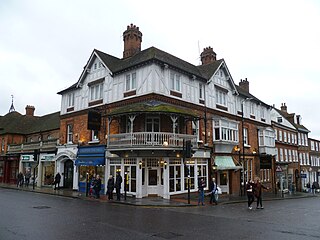
The Peahen is a public house in St Albans, Hertfordshire, England. The pub has been managed by McMullens Brewery since 1936.

The New Barnet War Memorial stands on a triangular plot at the junction of Station Road and Lyonsdown Road, New Barnet. It is grade II listed with Historic England.

The Finchley Meeting House is a Friends meeting house at 58 Alexandra Grove in Finchley, London N12.

The Hampstead Meeting House is a Friends meeting house at 120 Heath Street in Hampstead, London N3. It was designed by Fred Rowntree in the Arts and Crafts style. The friends had previously met in Willoughby Road from 1903. The Hungarian emigrant sculptor Peter Laszlo Peri was an elder of the Hampstead meeting; having joined in 1945.

Station Road is a road in New Barnet, northern Greater London, that runs from Station Approach and East Barnet Road in the east to the Great North Road and Barnet Hill in the west. It is joined on its northern side by Warwick Road and Plantagenet Road. On the south side it is joined by Gloucester Road, Mowbray Road, and Lyonsdown Road.
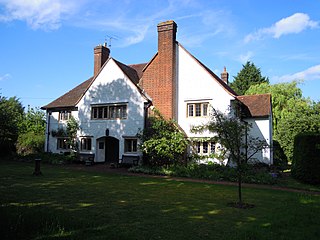
Howgills in Letchworth Garden City, Hertfordshire, England, is a Grade II listed building on the Register of Historic England in use as a Meeting House for the Society of Friends (Quakers).

Greenhill was a house and estate on the site of the former Pricklers estate to the south of Chipping Barnet, on the borders of Hertfordshire and Middlesex, in what is now north London.

Barnet Common was an area of common land to the south of the town of Chipping Barnet in what is now north London. The Common was created after a wood was cleared in the 16th century and was mostly used by local people to graze their animals. It was the location of a Digger colony and of the Barnet Physic Well at which mineral water was consumed. Part of the Common was enclosed in 1729 and the rest in 1815, leading to development on the north and south sides, and later infilling.



















